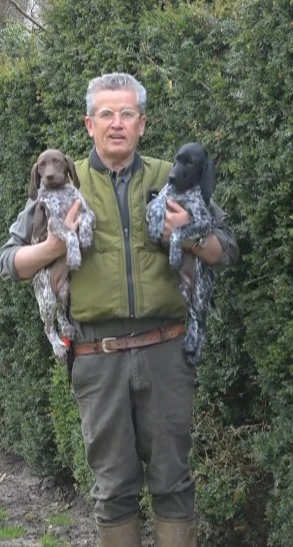
When the first warm rays of sunshine and the longer daylight announce spring, the time for maintenance pruning begins for many garden enthusiasts – and for me, this is the perfect moment to shape my yew hedge. Accompanying me: Lively German Shorthaired Pointer puppies who don't make it easy for me to stay focused! However, with the right timing and sharp scissors, hedge trimming becomes a rewarding garden routine.
The yew (Taxus baccata) is an evergreen conifer known for its exceptional tolerance to pruning. Yet even this robust classic needs regular care to maintain its dense form and vitality. Professional pruning prevents the plant from aging and ensures even, compact growth.
A particularly reliable indicator for the perfect timing is the flowering of the yew. When a fine pollen dust becomes visible after lightly shaking the branches, it's a sure sign: Now is the time for the first cut.
Important: Never prune yews in autumn! Late pruning can cause fresh shoots to freeze in winter. Instead, spring is ideal – after flowering and before the new growth really takes off. The main pruning should be done in June.
For shaping, I rely on two tools:
* Fine cutting with Japanese scissors: Perfect for precise touch-ups and shape corrections.
* Rough cutting with battery-powered hedge trimmers: For large-scale pruning, efficient and time-saving.
The yew forgives even deeper cuts into old wood. It reliably sprouts again – making it so easy to care for and shape. However, make sure to only make gentle corrections in late summer or early autumn to avoid frost damage.
Immediately after planting, pruning two to three times per year is sensible. This promotes branching and ensures fast, dense growth.
Once the hedge has reached its basic shape, one main pruning per year is sufficient. Additionally, a light corrective pruning can be done in late summer. However, this should not cut too deeply into old wood so that fresh shoots are not damaged by frost.
At some point, you may notice that the yew has become too thick and is no longer fully dense. In this case, it can be completely rejuvenated and radically reduced to the desired size. It will then sprout again from the old wood. For a hedge, this is done on one side first, and two years later on the other side. After 4-5 years, you will have a completely rejuvenated hedge.
* Cut conically: Make the hedge wider at the bottom and narrower toward the top. This ensures the lower area receives sufficient light and remains beautifully dense.
* Regularly sharpen cutting tools: Clean cuts injure the plants less and promote healing.
* Pay attention to the weather: Ideally, prune on dry, slightly cloudy days. Moisture can promote fungal infestations, while strong sun dries out fresh cut surfaces.
Those who regularly and properly prune their yew hedge will be rewarded with a dense, even, and healthy plant. This annual pruning is not just a maintenance measure but a small garden ritual – one that pays off throughout the entire year. Just don't let yourself be too distracted by curious puppies...
We use cookies to personalise content and to analyse our traffic. You consent to our cookies if you continue to use our website.